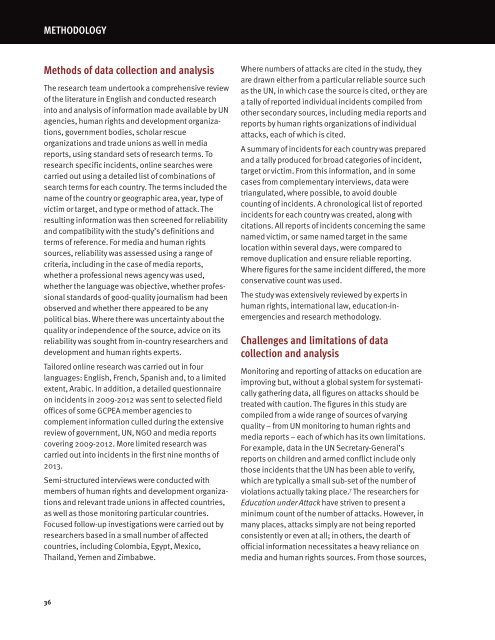Create successful ePaper yourself
Turn your PDF publications into a flip-book with our unique Google optimized e-Paper software.
MeTHODOLOGY<br />
Methods of data collection and analysis<br />
The research team undertook a comprehensive review<br />
of the literature in English and conducted research<br />
into and analysis of information made available by UN<br />
agencies, human rights and development organizations,<br />
government bodies, scholar rescue<br />
organizations and trade unions as well in media<br />
reports, using standard sets of research terms. To<br />
research specific incidents, online searches were<br />
carried out using a detailed list of combinations of<br />
search terms for each country. The terms included the<br />
name of the country or geographic area, year, type of<br />
victim or target, and type or method of attack. The<br />
resulting information was then screened for reliability<br />
and compatibility with the study’s definitions and<br />
terms of reference. For media and human rights<br />
sources, reliability was assessed using a range of<br />
criteria, including in the case of media reports,<br />
whether a professional news agency was used,<br />
whether the language was objective, whether professional<br />
standards of good-quality journalism had been<br />
observed and whether there appeared to be any<br />
political bias. Where there was uncertainty about the<br />
quality or independence of the source, advice on its<br />
reliability was sought from in-country researchers and<br />
development and human rights experts.<br />
Tailored online research was carried out in four<br />
languages: English, French, Spanish and, to a limited<br />
extent, Arabic. In addition, a detailed questionnaire<br />
on incidents in 2009-2012 was sent to selected field<br />
offices of some GCPEA member agencies to<br />
complement information culled during the extensive<br />
review of government, UN, NGO and media reports<br />
covering 2009-2012. More limited research was<br />
carried out into incidents in the first nine months of<br />
2013.<br />
Semi-structured interviews were conducted with<br />
members of human rights and development organizations<br />
and relevant trade unions in affected countries,<br />
as well as those monitoring particular countries.<br />
Focused follow-up investigations were carried out by<br />
researchers based in a small number of affected<br />
countries, including Colombia, Egypt, Mexico,<br />
Thailand, Yemen and Zimbabwe.<br />
Where numbers of attacks are cited in the study, they<br />
are drawn either from a particular reliable source such<br />
as the UN, in which case the source is cited, or they are<br />
a tally of reported individual incidents compiled from<br />
other secondary sources, including media reports and<br />
reports by human rights organizations of individual<br />
attacks, each of which is cited.<br />
A summary of incidents for each country was prepared<br />
and a tally produced for broad categories of incident,<br />
target or victim. From this information, and in some<br />
cases from complementary interviews, data were<br />
triangulated, where possible, to avoid double<br />
counting of incidents. A chronological list of reported<br />
incidents for each country was created, along with<br />
citations. All reports of incidents concerning the same<br />
named victim, or same named target in the same<br />
location within several days, were compared to<br />
remove duplication and ensure reliable reporting.<br />
Where figures for the same incident differed, the more<br />
conservative count was used.<br />
The study was extensively reviewed by experts in<br />
human rights, international law, education-inemergencies<br />
and research methodology.<br />
Challenges and limitations of data<br />
collection and analysis<br />
Monitoring and reporting of attacks on education are<br />
improving but, without a global system for systematically<br />
gathering data, all figures on attacks should be<br />
treated with caution. The figures in this study are<br />
compiled from a wide range of sources of varying<br />
quality – from UN monitoring to human rights and<br />
media reports – each of which has its own limitations.<br />
For example, data in the UN Secretary-General’s<br />
reports on children and armed conflict include only<br />
those incidents that the UN has been able to verify,<br />
which are typically a small sub-set of the number of<br />
violations actually taking place. 7 The researchers for<br />
Education under Attack have striven to present a<br />
minimum count of the number of attacks. However, in<br />
many places, attacks simply are not being reported<br />
consistently or even at all; in others, the dearth of<br />
official information necessitates a heavy reliance on<br />
media and human rights sources. From those sources,<br />
36


